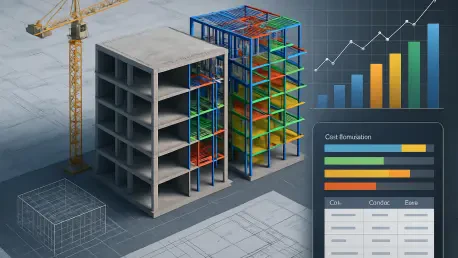In the ever-evolving landscape of construction technology, a groundbreaking shift is redefining how projects are planned and executed, with Building Information Modeling (BIM) taking center stage. Imagine a scenario where every design decision instantly reflects its financial impact, where budget overruns are spotted before they spiral out of control, and where project stakeholders collaborate seamlessly over a unified digital platform. This is no longer a distant vision but a tangible reality with the advent of 5D BIM, an advanced iteration of traditional modeling that integrates cost data directly into building models. By linking geometry, time, and now financial metrics, this technology transforms static designs into dynamic tools for real-time forecasting and decision-making. As construction grapples with chronic inefficiencies, the promise of turning architectural plans into precise financial roadmaps offers a compelling solution, setting the stage for a deeper exploration of its impact on the industry.
The Evolution of BIM Technology
The journey of BIM technology reveals a progressive expansion from basic design coordination to a multifaceted platform that encapsulates various project dimensions. Initially, 3D BIM revolutionized the industry by unifying architectural drawings into a cohesive digital model, eliminating design clashes and establishing a single source of truth for all stakeholders. This foundational step ensured that discrepancies between plans were caught early, saving time and resources. As the technology matured, the introduction of 4D BIM brought scheduling into the fold, allowing teams to simulate construction sequences and visualize timelines for tasks like material deliveries or structural installations. This added layer enabled better planning and coordination, reducing delays on-site. Now, with 5D BIM, the focus shifts to financial integration, embedding cost data into every model element. From beams to fixtures, each component carries a monetary value, updating budgets instantly as designs or schedules shift, thus creating a direct bridge between creative choices and fiscal responsibility.
Beyond the technical advancements, the significance of 5D BIM lies in its ability to address longstanding gaps in project management. Traditional methods often relied on static spreadsheets and fragmented data, leading to miscommunication and costly errors during execution. With 5D BIM, financial implications of design changes are no longer an afterthought but a core part of the planning process. Project teams can monitor cash flow requirements at every stage, pinpoint potential overruns, and explore cost-effective alternatives in materials or construction methods. This dynamic approach to cost visualization moves beyond mere numbers, offering a clearer picture of a project’s financial health in real time. Moreover, it paves the way for concepts like digital twins, where both physical progress and economic performance are mirrored digitally before ground is even broken. Such capabilities mark a pivotal shift, positioning 5D BIM as a cornerstone for modern construction efficiency and accountability.
Tackling Construction Inefficiencies
One of the most pressing challenges in construction has been the persistent issue of budget overruns and delays, often exacerbated by late design modifications and incomplete information. Research from leading industry analysts indicates that large projects frequently exceed budgets by as much as 80 percent and fall behind schedule by nearly two years. These inefficiencies stem from a disconnect between design intent and financial oversight, a gap that 5D BIM is uniquely positioned to bridge. By integrating cost data directly into building models, this technology ensures that every alteration—whether a material substitution or a timeline adjustment—reflects its budgetary impact instantly. Teams gain the ability to foresee financial risks early, allowing for proactive adjustments rather than reactive fixes. This seamless connection between digital design and fiscal workflows transforms how projects are managed, replacing outdated tools with a more responsive and accurate system for tracking costs.
Further enhancing its value, 5D BIM fosters a collaborative environment that breaks down silos between architects, contractors, and owners. The shared digital platform offers a continuously updated view of both progress and expenditure, reducing guesswork and enhancing transparency across all phases of construction. For developers navigating tight margins and rising financing costs, this foresight can determine whether a project remains viable or stalls due to unforeseen expenses. Additionally, the technology enables detailed analysis at each stage, helping identify cost-saving opportunities without compromising quality. Whether it’s optimizing resource allocation or reevaluating procurement strategies, the insights provided by 5D BIM empower decision-makers to act with confidence. As computing power and analytical tools continue to advance, the potential for even greater precision in financial forecasting grows, promising a future where inefficiencies are not just mitigated but systematically eradicated from the construction process.
Broader Implications and Future Horizons
The transformative potential of 5D BIM extends far beyond individual projects, offering a wealth of opportunities for portfolio-wide analysis and industry innovation. When a building model incorporates geometry, scheduling, and cost, it becomes a robust data set that stakeholders can leverage for broader insights. Owners can benchmark performance across different regions or asset types, identifying trends and inefficiencies at a macro level. Lenders, in turn, can adjust financing terms based on real-time project updates, while contractors streamline procurement by tying material orders directly to model elements. This interconnected data framework not only enhances operational efficiency but also redefines how value is assessed in construction. As a result, 5D BIM serves as a catalyst for strategic decision-making, enabling a more data-driven approach to managing multiple projects simultaneously and optimizing resource distribution across an entire portfolio.
Looking ahead, the trajectory of BIM technology suggests even more expansive applications, with concepts like 6D and 7D BIM on the horizon to incorporate sustainability metrics and energy performance. Imagine a future where models account for carbon footprints or lifecycle costs, providing a comprehensive ledger of a building’s environmental and economic impact. Such advancements could fundamentally alter how the industry operates, shifting focus from short-term gains to long-term value creation. The integration of artificial intelligence and enhanced computing capabilities further amplifies this potential, hinting at a time when BIM might model entire business strategies alongside physical structures. While adoption challenges remain, including the need for software integration and a cultural shift toward data-driven practices, the overarching trend is unmistakable. BIM is evolving into a holistic platform that captures every facet of a project, from inception through operation, setting the stage for a digitized construction landscape.
Reflecting on a Digital Transformation
Reflecting on the strides made by 5D BIM, it becomes evident that this technology marks a turning point in how construction intertwines design with financial accountability. It addresses chronic inefficiencies by embedding cost data into models, enabling real-time forecasting that curbs budget overruns and enhances risk mitigation. The collaborative transparency it fosters among stakeholders redefines project delivery, while its capacity for portfolio-level insights offers a new lens on efficiency. Looking forward, the groundwork laid by 5D BIM opens doors to future innovations, such as integrating sustainability metrics or leveraging AI for deeper analysis. For industry leaders, the next steps involve investing in training and system integration to fully harness this tool’s potential. Embracing partnerships with tech providers can also accelerate adoption, ensuring that the digital transformation of construction continues to evolve. Ultimately, the focus should remain on scaling these advancements to redefine not just individual projects but the broader operational framework of the industry.









